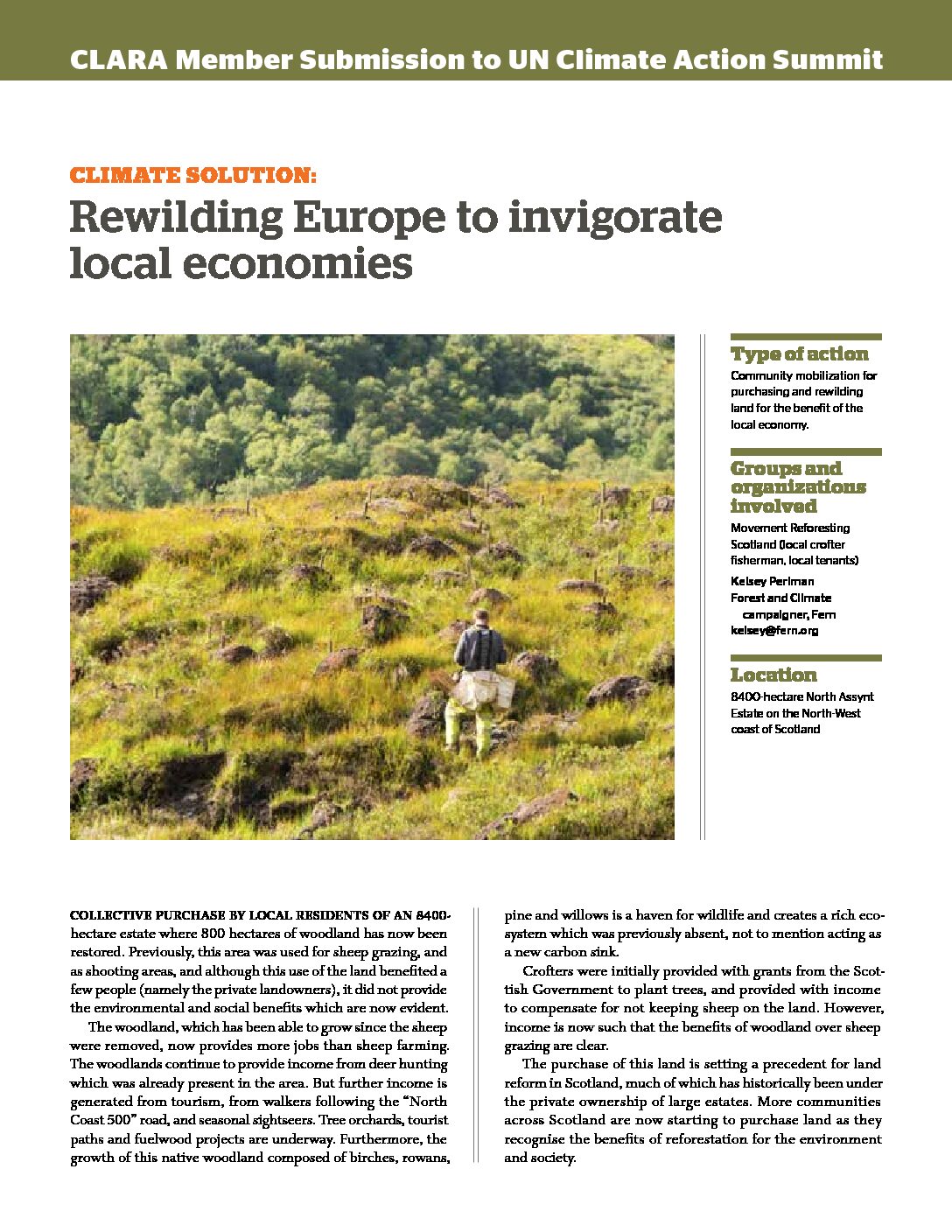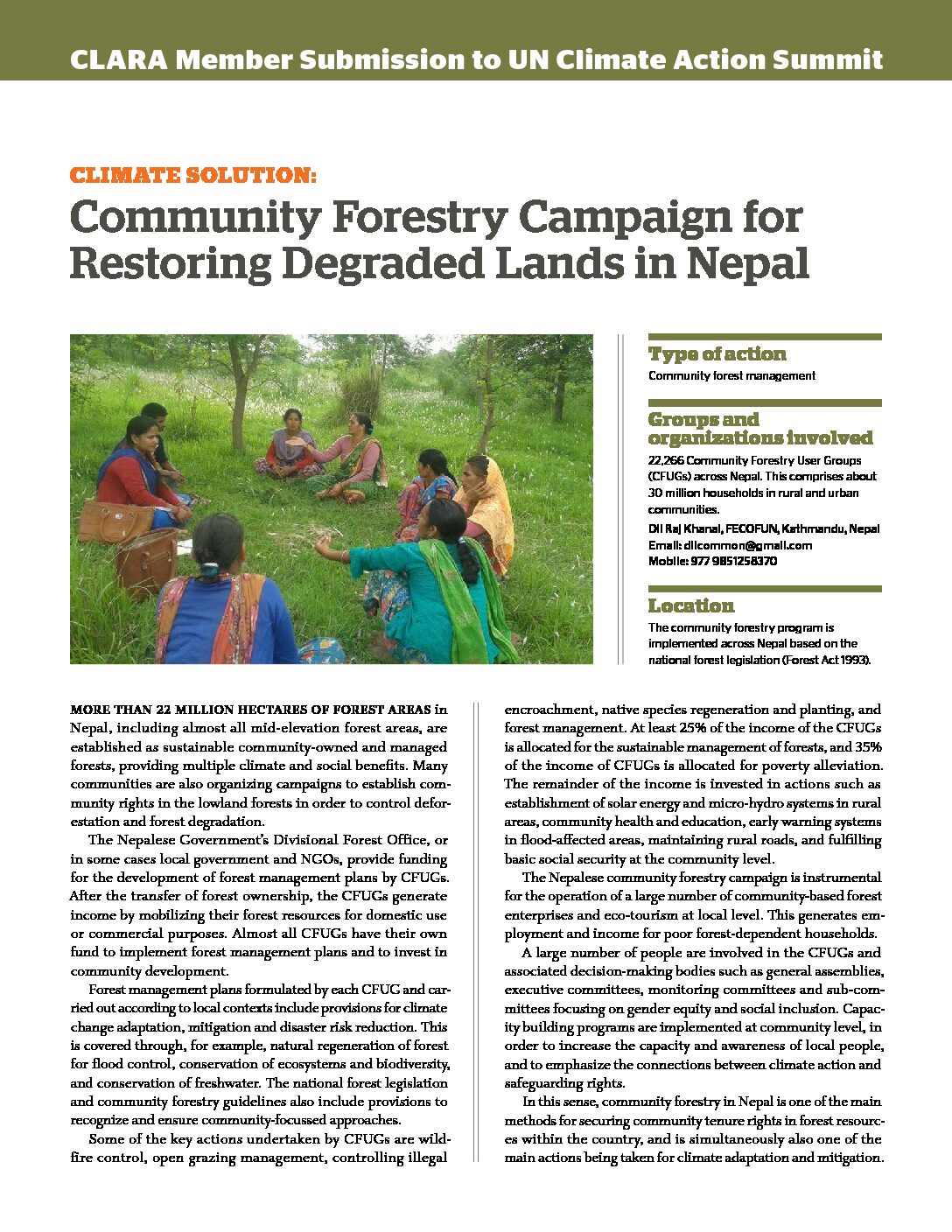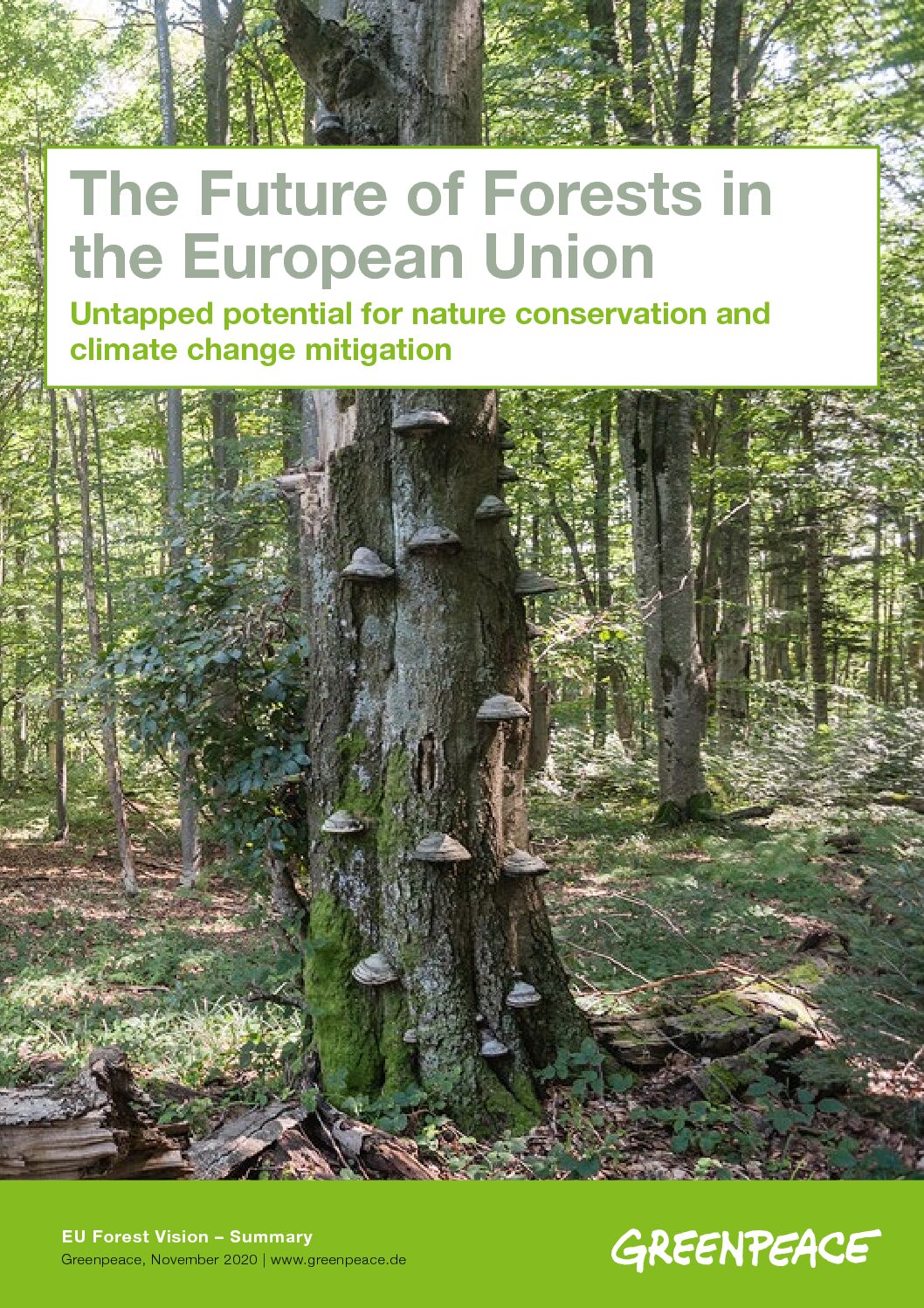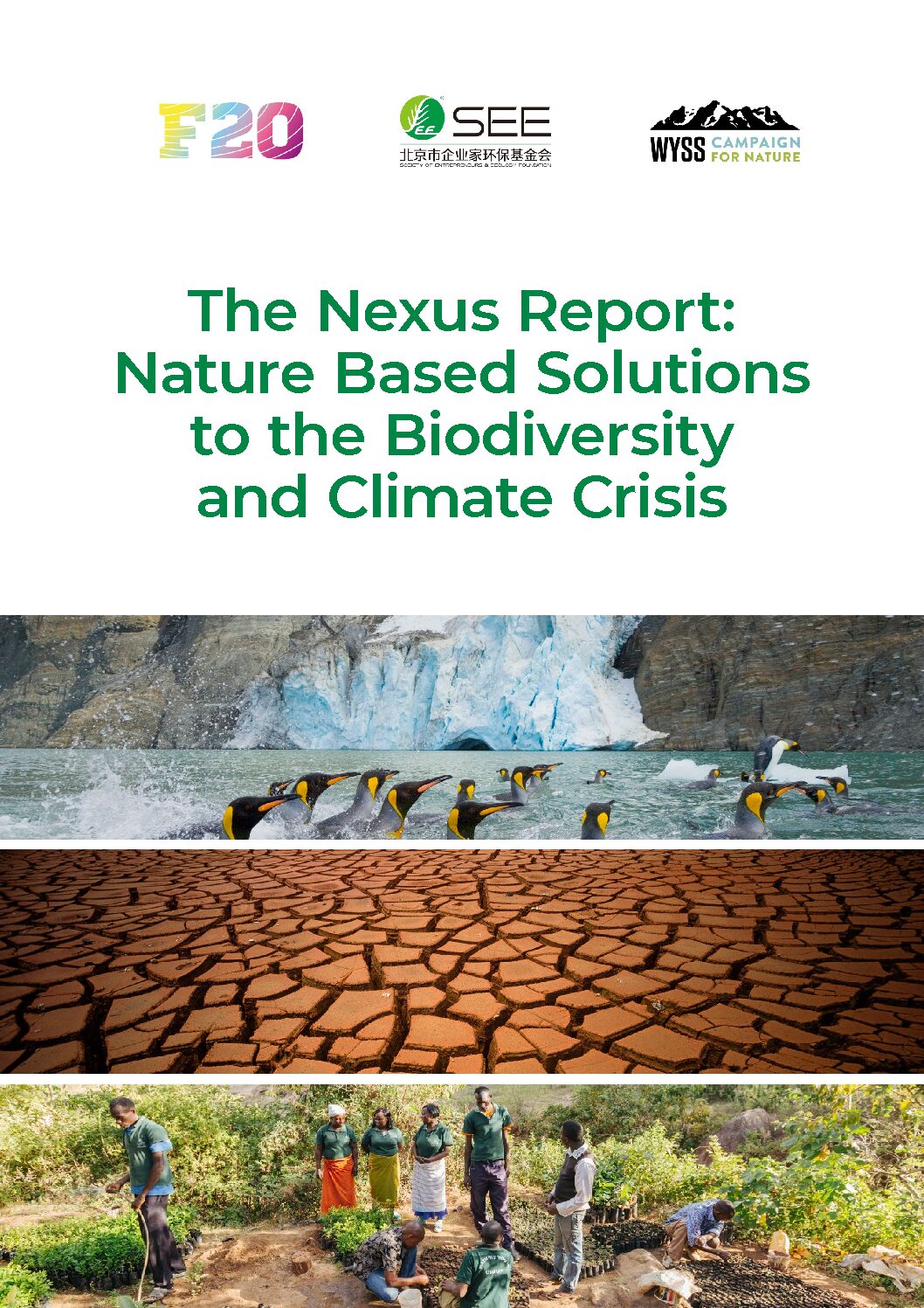Ecosystem Protection & Restoration
Ecosystem protection and restoration should be addressed as part of climate action, and included in all ‘nationally determined contributions’. The role of the land sector will vary from country to country. For ‘high-deforestation’ countries, eliminating further forest loss, and restoring those losses, can be a significant part of the overall national mitigation effort. ‘Low-deforestation’ countries can focus on activities to maintain standing forests. Countries suffering from desertification may focus their NDC on managing land for food security, while small island states may be most concerned with coastal protection.
Protecting existing intact ecosystems is the single most important action a country can take to maintain its existing ‘carbon sink’. NDCs that focus on protecting forests, re-growing degraded forests, and restoring other ecosystems are necessary as part of national ‘ambition’. But some NDCs also suggest that carbon sequestration from land protection and restoration can be sold as carbon credits, while other NDCs suggest replacing natural ecosystems with forest plantations.
So it’s important to know what’s proposed for land use climate action. Does the NDC call for a lot of ‘tree planting’ but includes no commitment to protect and restore natural ecosystems? Does the NDC suggest that part of the national ‘ambition’ that comes from land use change could be traded or sold to another Party? Does the NDC spell out a role for forests and land use beyond REDD+? Do land restoration opportunities also support livelihoods, food security, and resilience?
Protection
Protecting forests and other ecosystems is one of the key objectives under the Convention on Biological Diversity (see Target 15). CLARA members urge countries to address climate change and biodiversity loss in an integrated way, in pursuit of ‘ecological integrity’ and combined mitigation/adaptation benefits.
CLARA also notes that deforestation and forest degradation is a major contributor to global warming and harms the livelihoods of millions of people. CLARA members have called for a total ban on the clearing of primary forests worldwide. Ideally, NDCs will include both a commitment to protecting land (through parks and protected areas, indigenous reserves, and community conservation areas), as well as a ‘no deforestation’ commitment.
The clearing of natural forests to make way for cocoa, rubber or oil palm plantations continues to have a very negative on forest lands in the Global South. A ‘no net loss of forests’ policy is a step in the right direction, but isn’t as good as ‘no deforestation’, because ‘no net loss’ still allows for conversion of natural forests to plantations.
Best of all is a three-part commitment that a) ends deforestation, b) expands protection for natural ecosystems, and c) lays out an agenda for restoring forests, while protecting community rights.
This article from Nature Climate Change journal explores why this three-part commitment is necessary. The authors note that only 36% of the world’s forest is now primary forest. These ecosystems are irreplaceable – not only for biodiversity (see below) but also because of the carbon stocks they contain. All remaining primary forests should enjoy strict protection. Expanding protection of natural ecosystems also allows for the recovery of the forest’s carbon ‘sink’ capacity: ‘refilling the buffer that was depleted by human activities’. The paper further notes that forest conservation can avoid or reduce future carbon emissions, but cannot ‘in any meaningful sense’ offset emission from other sources. Finally, the authors call for a distinction to be made between natural forests ecosystems and plantations. Plantations offer only much lower per-hectare carbon storage potentials, as compared to natural forests.
This article from Nature Climate Change provides a detailed analysis of how land and forests in particular can contribute to achieving the Paris Agreement goal. That requires turning land use and forestry from a net anthropogenic source of emissions globally, as was the case from 1990–2010, to a net sink of carbon by 2030.
IUCN notes that while “restored or even degraded forests can offer some degree of environmental and ecological functionality”, they do not deliver the full range of benefits provided by primary forests. IUCN’s detailed policy on primary forests and intact forest landscapes can be found here.
The New York Declaration on Forests includes voluntary commitments, made by countries and companies, on protection and restoration of forests. In their NDCs, countries can indicate progress toward meeting the 10 Goals included in the Declaration. The Declaration website features case studies from China, Malawi, and El Salvador.
Restoration
The 2019 Intergovernmental Panel on Climate Change (IPCC) Special Report on Climate Change and Land clearly identified ecosystem restoration as a key element of ambitious climate action. The World Resources Institute has identified ~2 billion hectares of land that could be restored globally. Many countries have made voluntary commitments under the Bonn Challenge – the goal of which is to restore 150 million hectares of forest by 2020, and 350 million hectares by 2030. You can search your country’s pledge here.
The United Nations has also called for 2021-2030 to be the ‘UN Decade on Ecosystem Restoration’. Civil society groups should link land-use commitments in the NDC to outcomes of the ‘UN Decade’.
IUCN recently developed a Policy Brief on Forest Landscape Restoration (FLR) as an important component of NDCs. It highlights the opportunity for forest landscape restoration to be scaled up as both climate mitigation and adaptation measure. Landscape-level analysis and action is extremely important for addressing the twin challenges of climate change and biodiversity loss. Leading scientists have put together a list of 10 Principles for Landscape Level Approaches to forest restoration – principles that echo many of the themes of participation, multifunctionality, and recognition of land rights addressed elsewhere on this site.
Greenpeace Germany commissioned an in-depth study of the restoration and carbon storage potential of European forests. Greenpeace and academic colleagues found that a 30% decrease in logging rates could lead to a doubling of carbon capture by European forests. (For German-language original by Naturwald Akademie, click here.)
- Greenpeace: The Future of Forests in the European Union
Integrated Forest Landscape Management
The variety of competing land-use demands, and the different cultural contexts in which decisions about land use are made, makes it challenging to implement ecosystem protection and restoration. This paper, from colleagues at Griffith University, suggests looking at the forest landscape level. Management at that level requires a focus on three interconnected ‘pillars’: (1) ecosystem integrity, (2) effective planning and (3) strong governance.
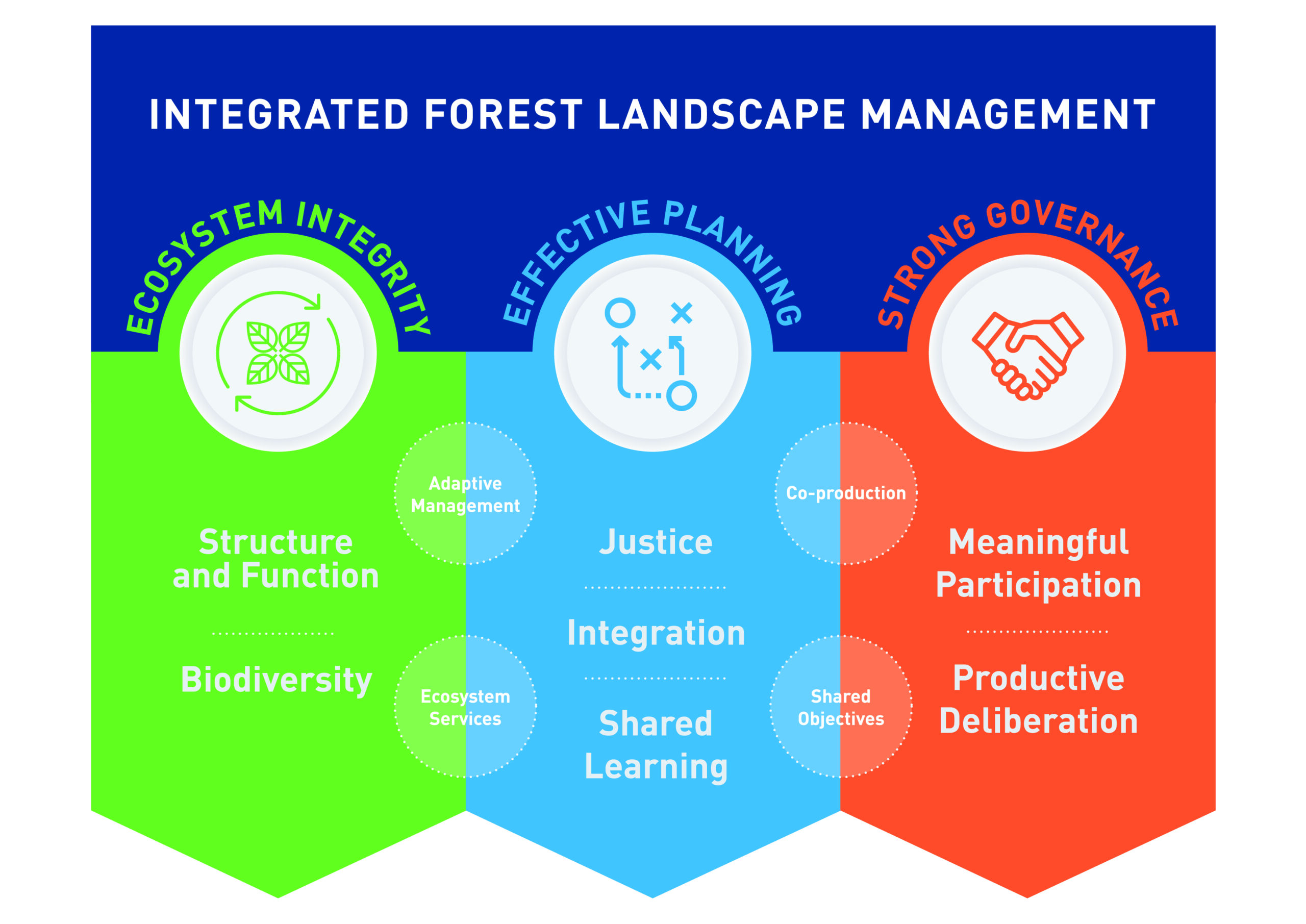
Courtesy of Griffith University
Ecosystem integrity determines what benefits a landscape can provide. That means the quality and quantity of its ecosystem services, and resilience – how the ecosystem sustains itself in response to impacts. Landscape management should focus on maintaining or strengthening ecosystem integrity by preserving biodiversity and ecosystem structure and function.
Planning allows communities and other stakeholders to choose current and future land uses across the landscape so benefits are used sustainably and shared equitably. Effective planning includes processes for (a) shared learning that incorporates and builds on scientific, local and Indigenous knowledge; (b) integration approaches that recognise the multiple values and goals of stakeholders; and (c) ensuring just outcomes, including fair benefit sharing and protecting rights.
Governance determines how stakeholders work together to reach legitimate decisions that are widely accepted. Strong governance requires meaningful participation of all and productive deliberation porcesses to create integrity in decision-making processes.
Biodiversity
In 2019, the UNFCCC acknowledged the importance of addressing climate change and biodiversity loss “in an integrated manner”. Doing so is crucial for reducing vulnerability to pests, disease, drought, and fire – threats that are already increasing as a result of climate change.
Several recent scientific reports make this key point about the need for integrative strategies to address biodiversity loss and slow down climate change. These reports include the IPBES 2019 Global Assessment Report on Biodiversity and Ecosystem Services, and the 2019 IPCC Special Report on Land. Among their conclusions:
- It’s impossible to replace primary ecosystems (like forests, wetlands, mangroves, and coral reefs) in time frames relevant for climate change (2030 – 2050).
- Deforestation must end immediately. Fragmentation of forests and other primary ecosystems is also a major problem that needs to be reversed.
- There are strong climate and biodiversity benefits associated with actions that increase connectivity between ecosystems, as well as ‘pro-forestation’, which means allowing previously logged or degraded forests to recover their biological potential.
- Agricultural systems can be restored using agroecological practices that maintain or increase biodiversity in soils, which in turn can improve farm productivity and carbon storage.
- There is much to learn from indigenous peoples and local communities as they address biodiversity loss and climate change in an integrated manner.
Despite these clear findings, there isn’t yet a joint work program involving the climate convention (UNFCCC) and biodiversity convention (CBD). Programs to link biodiversity and climate change responses are still scarce.
It’s important to ask what plans are included in your NDC or your national climate action plan to address biodiversity and climate change in a more integrated manner.
Here’s a good report about those linkages.
Protecting Rights
The needs of local communities should be taken into account in all activities to protect and restore ecosystems. The impact of protection and restoration on local livelihoods must be considered; and local people should be empowered to lead decision-making processes and actions related to restoration. Ecological restoration to ensure climate resilience and biodiversity will usually provide health benefits to communities while reducing threats from natural disasters. Local communities often have historic and detailed knowledge of nearby ecosystems, increasing the likelihood of success in protection and restoration.
Between 12% and 22% of the Earth falls under Indigenous Peoples and Local Communities’ Conserved Territories and Areas (ICCAs). That’s why locally-led forest (and grassland) restoration should be included in NDCs — because local communities are already significant stakeholders in land use decision. In 2018, CLARA produced a report “Missing Pathways to 1.5 Degrees”, where we discussed this issue and other related issues in detail.
CLARA members are very active in this area. Global Forest Coalition compiled information about supporting community conservation. FERN put together a briefing on how forests can help the EU tackle climate change. Forests of the World outlines key principles for rights-based restoration work. Rights and Resources provides an in-depth look at how recognizing community land rights can lead to lower deforestation rates, higher carbon storage, and higher levels of biodiversity.
What to Ask For
- Does the NDC acknowledge the fundamental importance of natural, biodiverse forests, and promote their protection and restoration?
- Does the NDC include any land-area targets for ecosystem protection and/or restoration?
- Does the NDC reflect key commitments already made under the Aichi Targets, the Bonn Challenge, and/or the New York Declaration on Forests?
- Does the NDC include a date by national deforestation and forest degradation must end?
- Does the NDC estimate ‘avoided emissions’ from ending deforestation, or a target for the amount of CO2 that can be sequestered by 2030 and 2050 through protection and restoration of ecosystems?
- Does the NDC distinguish between natural forests and single-species or non-native forest plantations? Are there proposals to replace natural forests with plantations?
- Does the NDC identify a goal (or goals) associated with tree-planting efforts?
- Does the NDC say anything about reducing imports of ‘deforestation commodities’ (palm oil, beef, soy, etc.) as a strategy for reducing consumption-related emissions?
- Does the NDC recognize any existing moratorium on the conversion of peatland or other wetland ecosystems? Is there a separate restoration (or ‘re-wetting’) target associated with peatlands?
- Does the NDC include clear, practical measures through which local communities will be included in protection and restoration actions?
- Do actions for protection and restoration outlined in the NDC respect and enhance community rights and ownership (of land and natural resources)?
- Does the NDC include training for local communities in ecosystem protection and restoration?
- Does the NDC describe payment programs to land-owners and farmers who carry out restoration and/or shift production into tree crops and other agroforestry approaches?
- Does the NDC talk about trading or selling ‘forest carbon credits’?
- Are ideas for, or approaches to, monitoring and verifying results from land restoration included in the NDC?
Good Practice
In February 2019, Costa Rica presented its National Decarbonisation Plan 2018-2050, which the goal of reaching ‘net-zero’ emissions by 2050. This plan is more ambitious than the country’s 2030 and 2050 targets under the Paris Agreement, and will inform its updated Nationally Determined Contribution in 2020. Ecosystem restoration plays an important role in how the country will meet its targets.
Between 1943 and 1986, Costa Rica’s forest cover dropped from 77% to 41% of the country’s total land area due to logging. But in the 1980s Costa Rica began investing in ecological restoration, and through such ambitious activities, forest today covers 75% of the country. Not only are Costa Rica’s forest ecosystems recovering, but poverty has been reduced, because the forest provides many more livelihoods than farming and timber-cutting alone.
In 1986 the Costa Rican Government created the National Forest Financing Fund (FONAFIFO) in recognition of the multiple benefits provided by a healthy rainforest. Sourced via foreign support plus domestic taxes, this fund provides compensation to communities and individuals who protect forests.
Additional resources:
https://climateactiontracker.
https://ndcpartnership.org/
https://www.fonafifo.go.cr/en/
FERN and groups from Vietnam prepared a report on Vietnam’s NDC. It looks at current forestry issues in Vietnam from forest governance standpoint and the role of civil society in helping solve these issues.
- FERN: Report on Vietnam’s NDC
Further Resources
Natural Climate Solutions – an academic paper co-authored by a group of scientists from NGOs and universities – quantified twenty land management actions that increase carbon storage or avoided greenhouse gas emissions. They call these ‘natural climate solutions’ (NCS).
Library Resources
Protection
- Untangling the confusion around land carbon science and climate change mitigation policy
- IUCN Policy on Primary Forest and Intact Forest Landscapes
- Key Role of Forests in Meeting Climate Targets
- New York Declaration on Forests
Restoration
- Bonn Challenge
- Restoration Opportunity
- ‘Natural Climate Solutions’
- UN Decade
Protecting Rights
- Community Conservation
- Rights-based Restoration
Case Studies
- Costa Rica
- China
- Malawi
- Vietnam
